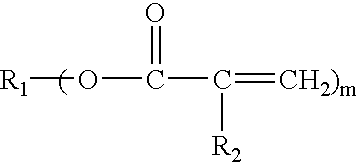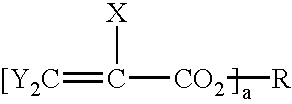[0014] The present invention involves asymmetrically cladding the core to solve the above problems. Typically, a cladding is formed uniformly around the core. Adding a buffer of index lower than the clad underneath the under clad solves the problem of loss due to light absorption by the substrate as mentioned above. According to this invention, if the underclad is removed, then each of the above problems is solved. The use of a buffer that has a
refractive index much lower than that of the core has several benefits. The buffer keeps the
tail of the core mode from extending into the substrate, thus keeping the light from leaking into the substrate. The buffer keeps the light from leaking into the substrate, thus eliminating the main reason for
polarization dependent loss (PDL) where TM-polarized light can incur significantly higher loss than TE-polarized light. The buffer has a low enough
refractive index to keep the light from leaking into the substrate even when heating is performed. When an under clad is not used and a substantially non-photolocking buffer is used, the formation of a secondary waveguide under the core waveguide is avoided when the core is patterned by
exposure to
radiation. If the waveguide incorporates a
grating and an under clad is not used, secondary reflections due to a guide in the under cladding are avoided. If the waveguide incorporates a
grating and an under clad is not used, the buffer photolocks just enough to have a grating imprinted in it when the grating is imprinted holographically in the waveguide and allows one to avoid loss of light by
coupling to cladding
modes. In this case the term holographically imprinted means a grating that is produced in the volume of the material which comprises the waveguide by a periodic modulation in the index of refraction. Such a grating may be contrasted with a surface-relief grating, which is produced by a periodic variation in the
topography of the surface of either the core or cladding of the waveguide. In both cases the effect produces a periodic variation in the effective index of refraction along the propagation direction of light within the waveguide.
[0015] Additionally, due to the height of the core, the overclad typically has a bump on it that can be quite large. This can occur in
polymer waveguides in which polymers must be spin cast from a
solvent solution due to their high molecular weight and
viscosity. It can also occur in silica waveguides in which
chemical vapor deposition of the overclad applies a uniform layer on top of the core. In addition, reactive-
ion etching of
polymer or
glass waveguide cores can result in high propagation losses due to scattering of light caused by rough side walls. Waveguides can be made using photopolymerizable
optical materials which can be coated and cured on a substrate. Typically, the materials include. mixtures of monomeric and oligomeric components which are blended to provide the correct index of refraction. Mixtures are blended to provide a an between core and clad, of typically 0.5 to 2 percent. In the
photolithography of these curing mixtures, typically a guiding region having an index gradient instead of a step index can be formed in the under clad layer. Also, a region can form at the side and the top of the core in which an index gradient is found instead of a step index. The formation of the gradient index in the region surrounding the core is due to migration of dissimilar chemical components, particularly a
monomer component moving from the core layer into the cladding
layers. In the region directly under the core, the monomers can further react during the formation of the core forming an unwanted guiding region within the under cladding layer. When the underclad region is of about the same thickness as the core, a guiding layer can be formed that penetrates the
full thickness of the under clad. In extreme cases it can be as intensely guiding as the core itself and allows light to reach the
substrate surface. Since the substrates of this invention are absorbing at optical wavelengths of importance to
telecommunications, any portion of the propagating light that reaches the substrate is subject to absorption. Absorption of light by the substrate leads to a severe undesirable polarization-dependent loss of
optical power from the propagating signal. Attempts have been made in the art to resolve these issues. One potential solution uses a thick under cladding layer to isolate the core from the substrate to prevent this undesirable result. This eliminates the problem to the desired degree, however, it requires the use of an impracticably thick under cladding. Another solution includes using a buffer region with an index which is 2% or more lower than the core, wherein the buffer region is below the underclad. Even if
monomer diffusion occurs deeply through the under clad and slightly into the buffer, the guiding in the buffer will be greatly suppressed, eliminating most light absorption by the
silicon. However, the under clad can still guide light and
multimode waveguides with
residual polarization effects can still result.
[0017] It would be desirable to produce optical devices from polymeric materials which have low absorption and
scattering loss at application wavelengths, have precisely controllable refractive indexes for mode and
numerical aperture control. Precise refractive index control allows control of mode and numeric aperture and permits fabrication of
single mode waveguides that match single-mode fibers in both cross sectional dimensions and numeric aperture. When the core and cladding materials are comprised of two or more miscible monomers, the index at each layer of a waveguide can be precisely tailored by mixing selected pairs of
high index and low index monomers. This property can be used to precisely control the mode of a waveguide and can be used to fabricate large-size single-mode waveguides that match commercial single-mode fibers in both cross sectional dimensions and numeric aperture.
[0018] In this invention, a planar waveguide structure is formed in which only a buffer, a core, and an overclad are applied to a substrate. A buffer layer is formed on a substrate and cured. A core layer is applied on top of the buffer layer. During the core application and cure,
diffusion of low molecular weight,
high index of refraction material takes place and increases the index of the buffer. A gradient index is formed through the buffer. The gradient index then sharply falls off with distance into the buffer region. However, the core, cladding and buffer are chosen such that optical multimode behavior is frustrated for all potential values of buffer index. In addition, an overcladding is applied, which coats both the sides and the top of the core. A similar
diffusion of
high index monomer occurs thereby assuring a gradient index around the core. According to this invention, clear single-mode performance can be combined with exceptionally low
coupling loss due to the improved
mode matching with round-core single-mode fibers.
[0019] The components described in this invention are formed by only three
layers on top of the substrate: a buffer layer of index n.sub.b; a core layer of index n.sub.c; an overclad layer of index n.sub.o with n.sub.b<n.sub.o<n.sub.c. In this invention, multi-layer
photonic integrated circuit components are fabricated with a core of index n.sub.c surrounded on top by an overclad of index n.sub.o<n.sub.c and at the bottom by a buffer of index n.sub.b<n.sub.o, permitting one to achieve low optical loss, low
polarization dependent loss, no optical power drop with heating, no secondary waveguide under the core waveguide; no secondary reflections and no (or very low)
cladding mode loss in the presence of a volume grating.
 Login to View More
Login to View More  Login to View More
Login to View More 


